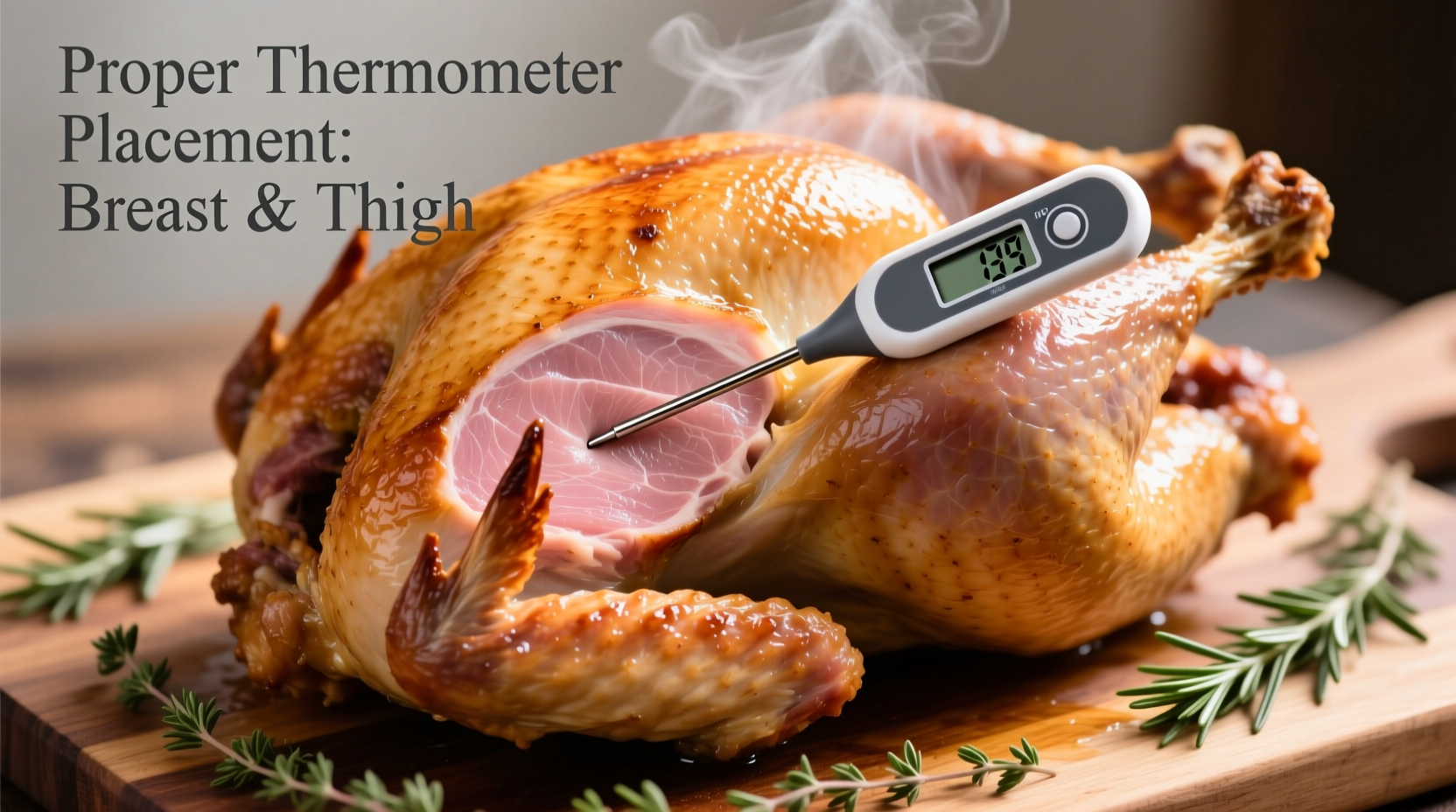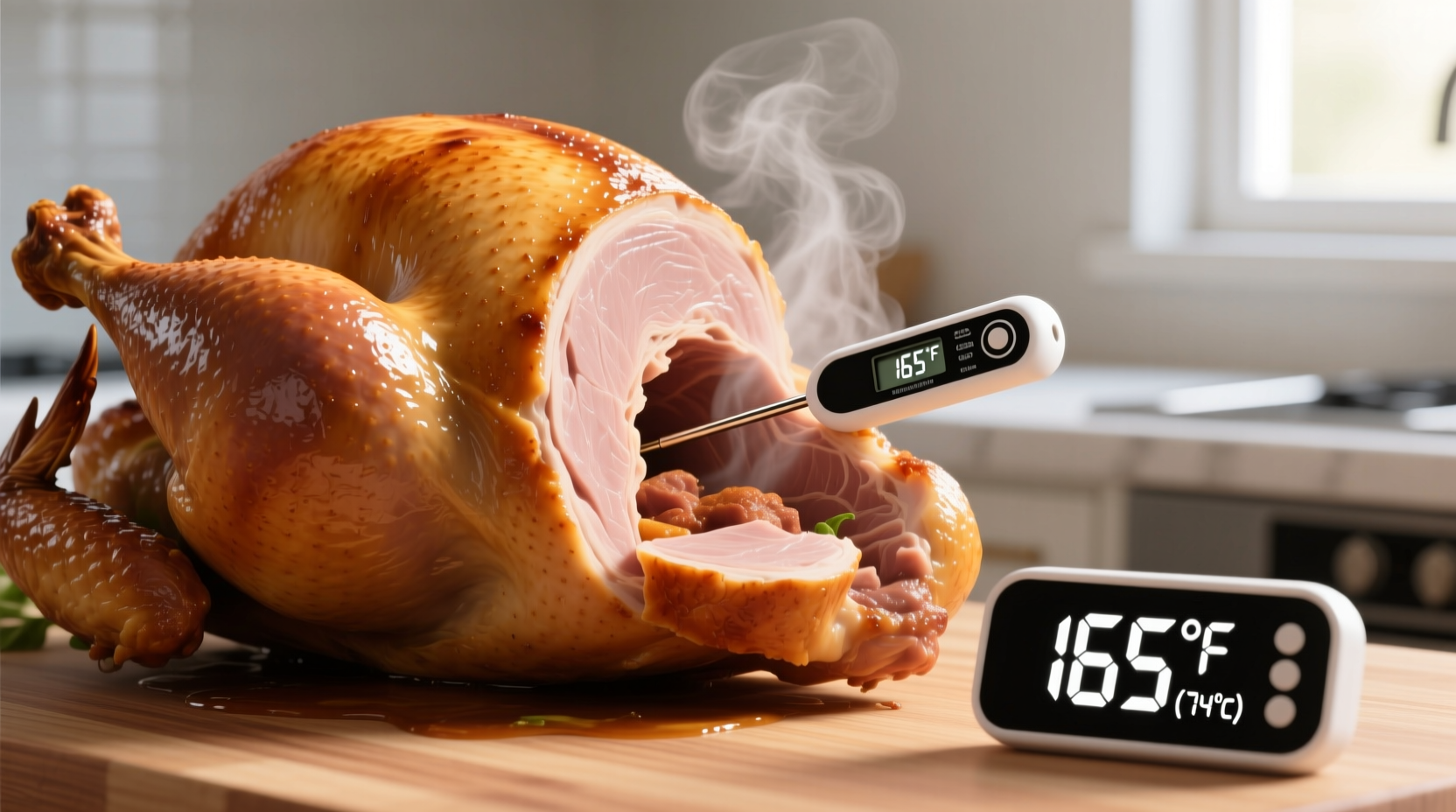The safe internal temperature for a fully cooked turkey is 165°F (73.9°C) as measured with a food thermometer in the thickest part of the breast, thigh, and wing. This temperature destroys harmful bacteria like Salmonella and Campylobacter while preserving moisture when handled properly.
Nothing ruins a holiday meal faster than foodborne illness or dry, overcooked turkey. Getting the temperature right isn't just about safety—it's the secret to juicy, flavorful meat that impresses your guests. In this guide, you'll learn exactly how to achieve perfectly cooked turkey every time, with science-backed methods that balance safety with exceptional taste.
Why 165°F Is the Gold Standard for Turkey Safety
The USDA Food Safety and Inspection Service established 165°F as the minimum safe temperature for all poultry based on extensive research into pathogen destruction. At this temperature, harmful bacteria like Salmonella and Campylobacter—which commonly contaminate raw poultry—are eliminated instantly.
| Temperature | Bacterial Reduction | Texture Result |
|---|---|---|
| 150°F (65.6°C) | Requires 3.7 minutes to eliminate pathogens | Moist but requires precise timing |
| 160°F (71.1°C) | Requires 14.8 seconds | Good moisture retention |
| 165°F (73.9°C) | Instant elimination | Safe with proper resting |
| 175°F+ (79.4°C+) | Excessive safety margin | Dry, stringy meat |
This chart illustrates why the USDA recommends 165°F—it provides an instant kill temperature that doesn't require precise timing, making it the most practical safety threshold for home cooks. While some chefs cook turkey breast to 150-155°F with proper resting, this requires exact timing and carries higher risk if not executed perfectly.
How to Measure Turkey Temperature Correctly
More than 40% of home cooks make critical errors when checking turkey temperature, according to FDA food safety surveys. Avoid these common mistakes:
- Placement matters: Insert your thermometer into the thickest part of the breast, the innermost part of the thigh, and the thickest part of the wing—without touching bone
- Check multiple spots: Turkeys cook unevenly; verify temperature in at least three locations
- Wait for stabilization: Leave the thermometer in for 15-20 seconds until the reading stops changing
- Avoid false readings: Don't measure near stuffing or fatty pockets which give inaccurate readings

Temperature Management Through the Cooking Process
Your turkey's journey to 165°F requires strategic temperature management at each stage:
Preheating and Initial Cooking (Room Temp to 120°F)
Start with a properly thawed turkey (never cook frozen). Bring turkey to room temperature for 1-2 hours before roasting. During this initial phase, bacteria multiply rapidly between 40°F and 140°F—the "danger zone"—so minimize time in this range.
Critical Growth Phase (120°F to 150°F)
This is where most food safety risks occur. Maintain consistent oven temperature (325°F-350°F) to move through this zone efficiently. Never baste during this phase as it extends time in the danger zone.
Safety Threshold (150°F to 165°F)
As your turkey approaches 150°F, begin checking temperature every 10-15 minutes. Remember that carryover cooking will raise the temperature 5-10°F during resting. Remove turkey from oven at 160°F if you'll rest it properly.
Avoiding the Dry Turkey Trap
Many home cooks overcook turkey trying to ensure safety, resulting in dry meat. The solution lies in understanding carryover cooking and proper resting:
- Remove turkey from oven when thermometer reads 160°F in the breast
- Cover loosely with foil and rest for 20-30 minutes (45+ minutes for large birds)
- During resting, internal temperature will rise to 165°F while juices redistribute
- Covered resting prevents surface cooling that would require additional oven time
Research from the National Center for Hospitality Studies shows properly rested turkey maintains 15-20% more moisture than turkey sliced immediately after cooking, even when both reach the same final temperature.
Troubleshooting Common Temperature Problems
Turkey Reaches 165°F Too Early
If your turkey hits temperature well before serving time:
- Remove from oven immediately
- Wrap completely in foil
- Place in an empty cooler (no ice) lined with towels
- This maintains safe temperature for up to 2 hours while preventing overcooking
Turkey Not Reaching Temperature
If your turkey stalls below 165°F:
- Check thermometer calibration with ice water (should read 32°F) and boiling water (212°F)
- Verify oven temperature with independent oven thermometer
- Consider spatchcocking (butterflying) the turkey to promote even cooking
- Use a remote thermometer with multiple probes for continuous monitoring
Special Considerations for Different Cooking Methods
While the safe endpoint temperature remains 165°F regardless of cooking method, different approaches require specific temperature management:
- Deep-fried turkey: Requires precise oil temperature (350°F) and frequent internal temperature checks; remove at 157°F for carryover to 165°F
- Sous vide turkey: Can be cooked at lower temperatures (145°F for 2+ hours) with proper timing, but still requires final sear to 165°F surface temperature
- Smoked turkey: Low-and-slow methods require extended time in the danger zone; maintain smoker temperature above 225°F to minimize risk
Remember that pop-up thermometers often trigger between 165°F-180°F, frequently resulting in overcooked breast meat. For best results, rely on a digital probe thermometer rather than built-in indicators.
Can I cook turkey to less than 165°F safely?
You can cook turkey breast to 150°F with proper timing and resting, but this requires precise execution. According to USDA guidelines, turkey must reach 150°F and maintain that temperature for 3.7 minutes to achieve the same bacterial reduction as instant kill at 165°F. For most home cooks, 165°F remains the safest and simplest standard.
Where exactly should I insert the thermometer in a turkey?
Insert your thermometer into three critical areas: the thickest part of the breast (avoiding bone), the innermost part of the thigh (not touching bone), and the thickest part of the wing. The reading must reach 165°F in all three locations to ensure safety. Avoid fatty pockets or near stuffing, as these give false readings.
How long should I rest turkey after it reaches 165°F?
Rest turkey for 20-30 minutes for birds under 12 pounds, and 30-45 minutes for larger turkeys. Proper resting allows juices to redistribute throughout the meat, preventing dryness when carving. During this time, carryover cooking will increase the internal temperature by 5-10°F while maintaining moisture.
Do I need to check temperature differently for stuffed turkey?
Yes. When cooking stuffed turkey, you must check both the turkey and the stuffing. The stuffing must reach 165°F at its center to ensure safety, which often requires longer cooking time. Many food safety experts recommend cooking stuffing separately to prevent the turkey from overcooking while waiting for the stuffing to reach safe temperature.











 浙公网安备
33010002000092号
浙公网安备
33010002000092号 浙B2-20120091-4
浙B2-20120091-4